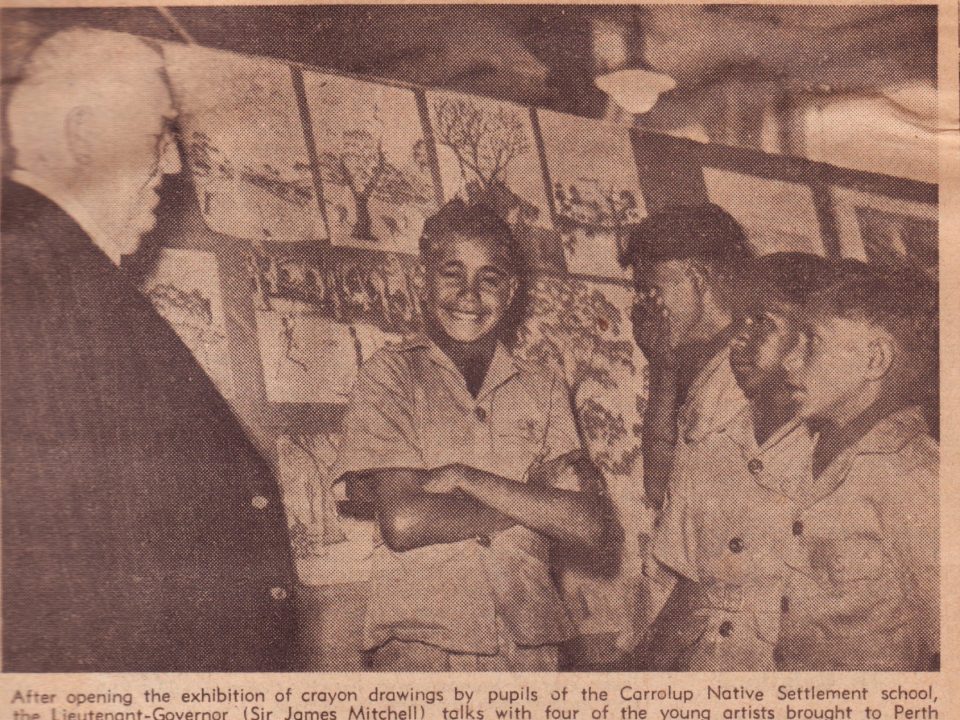In a previous blog, I described how the Carrolup children’s art was exhibited in the ‘Crystal Section’ of Boans, the largest department store in Perth, from October 21 to October 24, 1947, thanks to the initiative of teacher John Stokes. The exhibition of over 400 Carrolup drawings was opened by Western Australia’s Lieutenant-Governor, Sir James Mitchell.
Four of the boys—Reynold Hart, Parnell Dempster, Barry Loo and Claude Kelly—aged between ten and twelve years, and dressed in safari suits made by Mrs White, demonstrated their skills twice daily at the exhibition. The event attracted large crowds and a total of £120 was raised from art sales and donations. This money was to be held in trust by the Department of Native Affairs. [The sum of £120 is equivalent to just over $8,000 in today’s money.] Reviews of the exhibition were favourable.
‘The organiser of the display (Mr. J.P. Stokes) said yesterday that the exhibition was one of the most significant held in Perth for many years. It showed that there was in native children rich latent talent which needed only opportunity to be developed….’ The West Australian, News and Notes, 3rd November 1947.
I continue with an extract from my book Connection: Aboriginal Child Artists Captivate Europe:
‘Dorothy Hewett, acclaimed poet, novelist and playwright, makes her opinion of the exhibition very clear in her article Carrolup Children’s Art is Exciting for The Workers Star [1].
‘Walking into Boan’s third floor last week was like walking into the vigorous adventure of a child’s mind.
The children from the Carrolup Native Settlement were displaying one of the most exciting exhibitions ever seen in Perth…
Last week their exhibition drew excited crowds, hundreds of the drawings were sold, and the Curator of the Art Gallery is enthusiastic about their work.
I think that a further proof of the vividness and truth in these drawings is the reaction of other children. The exhibition was full of them, pointing excitedly, dropping hints to parents to buy “that beaut one”, triumphantly carrying off “my picture”.’
Ms Hewett has something to say to government about Aboriginal people:
‘Their paintings are a vigorous challenge to the neglect and ignorance of the Native Affairs Department’s policy towards Aborigines and colored Australians.
United pressure by the public, who were so enthusiastic at the exhibition, is needed to see that native children are given every opportunity to advance their special skills and aptitudes.’
In The West Australian of the 1st of November, M L Skinner writes:
‘The other day four boys sketched pictures in a Perth emporium. They were native boys in neat shorts and coats, drawing from inspiration without model or help of any sort. They were given merely a box of chalks and sheet of paper and told to draw what they liked. Perhaps they were a little overpowered by the presence of many strange white people and no doubt were rather self-conscious; but directly they handled the chalk they were away, gripped by the delicate tendrils of their imagination. They leapt over the barriers of convention and into the hills far away.’
M L Skinner is likely the writer Mary Louisa ‘Mollie’ Skinner, who spent time as a nurse at the Moore River Native Settlement during the 2nd World War.’ Connection: Aboriginal Child Artists Captivate Europe. David Clark, in association with John Stanton. Copyright © 2020 by David Clark
[1] Dorothy Hewett, Carrolup Children’s Art is Exciting, The Workers Star, 31st October 1947 (Trove)


